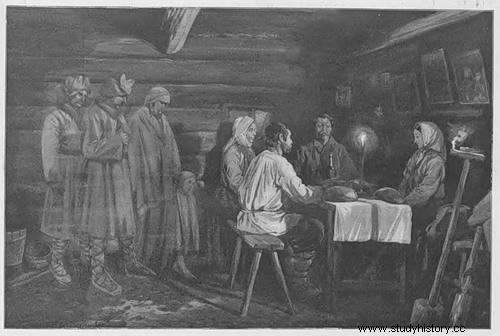"Dark everywhere, deaf everywhere ... what will it be? What will it be? ... ”- the famous quote from Mickiewicz's Dziady has become a permanent part of our cultural consciousness. But what do we know about the pre-Christian ritual, the essence of which was the meeting of the living with the dead?
Romantic horror - beings out of this world
Belief in supernatural phenomena. Taming death. References to ancient beliefs and sometimes forgotten legends. Questions related to what follows this life ... Romanticism is a cultural current that gave rise to new trends in art and literature. It lasted from the 1890s to the 1840s. National seers, including Adam Mickiewicz, referred in their works to national history and spirituality that had been seemingly forgotten. As with the grandfathers' rite.
In fact, it was a set of special rituals related to the relationship of the living with the dead. Interestingly, the name dziady was used in folk dialects in Belarus, Polesie, Russia and Ukraine interchangeably with terms such as skirts, wires, radecznica or all-time souls. How did the Slavs celebrate the Ancestors' Day? And what's left of us today of pre-Christian traditions?
Because it should be noted that the rite known from the famous work of Mickiewicz, however, differs in details from the actual ritual of summoning ghosts. The action of the second part of Forefathers' Eve takes place during the Suffocation Day - at night, in a chapel, where a group of people from a nearby village gathered. They are chaired by Guślarz. The gathered call the souls in Purgatory one by one, wanting to alleviate their suffering. Three kinds of ghosts come at their call.
Light - as we remember reading - symbolized by children, Józia and Rózia, who did not experience any suffering during their lifetime, indirect - the spirit of Zosieńka, a shepherdess girl who played on the feelings of other mortals, and heavy, i.e. the ghost of a master who ruthlessly hurt his subjects .
In fact, however, the most important part of the grandfathers was the opportunity to meet the spirits of the ancestors which at an exceptional time temporarily returned to their hometown. Connecting with the world of the dead, however, required proper preparation, a kind of a special occasion.
Time to meet the ghosts
In the Slavic tradition, the day of meeting the dead was celebrated several times a year. The most important dates, however, were the solstices:the turn of April and May, as well as the autumn night - from October 31 to November 1. All Souls 'Night - preparation for All Souls' Day.
According to old beliefs, under the so-called The Feast of the Ancestors had to properly accommodate the arriving souls - to gain their favor, trust and protective power. Special considerations could be obtained with appropriate food and drink, such as groats, bread, honey, eggs or kutia. It is worth noting that they feasted not only in homes, but also in cemeteries - directly on the graves of their loved ones. In this way, they wanted to establish a connection with the sacrum zone .

Dziady in Belarus
One of the most important rituals was lighting a fire, which was to light the way for wandering souls - so that they would not get lost, but spend time with their loved ones on Earth. And here an important note - the remnants of this custom are ... contemporary candles lit on graves, obvious symbols of memory from which a charming glow floats during the November holidays.
There was also another interpretation of lighting fires. Fire was supposed to be a natural barrier for the souls of people who died of sudden, tragic death - suicides or drowned people. Because it is from them, according to beliefs, that ghosts, strigoi, ghosts, drowners and ghouls could "born", which instead of happiness and peace would introduce terror during a reflective meeting between the worlds.
Find out more:Pantheon of Slavic gods. Did Jan Długosz really describe the belief system of old Poles?
Dziady - the story of the returning dead
In ritual rituals a special, though sometimes anonymous role was played by beggars, who were also called grandfathers in many parts of the Slavic region. They were a kind of medium, spiritual guides who had the knowledge that allowed contact with immortal beings. And that is why they were asked to pray for the souls of their deceased ancestors, in return offering a special meal or sharing money donations.
In Mickiewicz's "Dziady" there appears the figure of the Guślarz, an individual who in the religion of the Slavs was considered either a fortune-teller, a magician, or a shaman, a guide in the ritual tradition.
Interestingly, in the case of the grandfathers, both the Catholic and the Orthodox Church tried to eradicate the old customs, and then - at a very similar, and sometimes even the same time - to introduce their own religious rites. An interesting issue is also that Dziady is cultivated in most Slavic pagan movements (including indigenous ones), usually under the name of the Ancestors' Festival.
As you can see, the stories of the returning dead have survived not only in historical chronicles and literary works, but also in traditions sanctified by various national cultures.
Bibliography:
- Dziady. It is about wandering beggars and their songs , Piotr Grochowski, Scientific Publishers of the Nicolaus Copernicus University, 2009.
- Vampire. Symbolic biography , Maria Janion, Publishing House of Word / Image of Territories, 1.11.2008.
- Mythology of the Slavs , Aleksander Gieysztor, Publishing House of the University of Warsaw, 01/01/1982.
